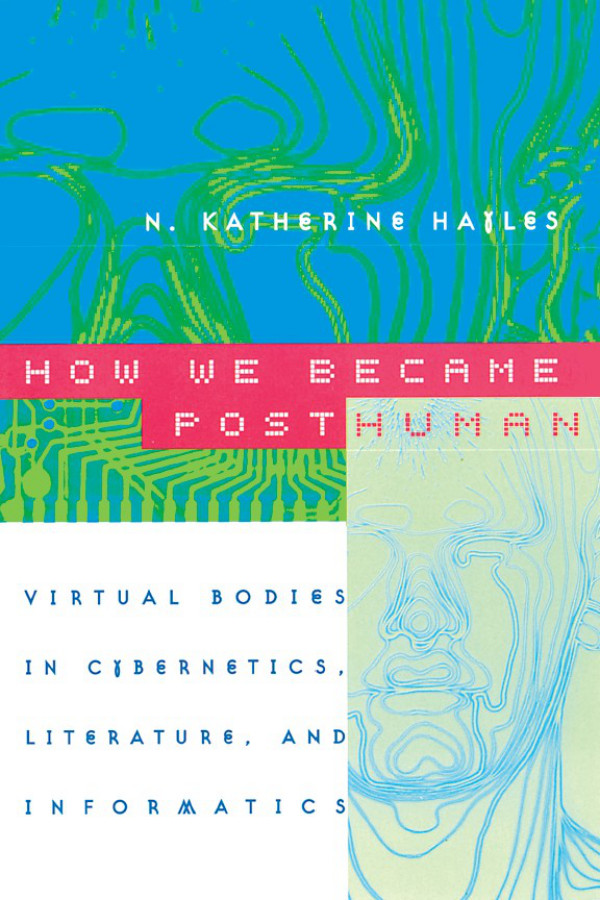N. Katherine Hayles: How We Became Posthuman: Virtual Bodies in Cybernetics, Literature, and Informatics (1999)
Filed under book | Tags: · android, artificial intelligence, autopoiesis, body, cellular automata, computing, cybernetics, cyborg, epistemology, literature, posthuman, posthumanism, technology, virtual reality

“In this age of DNA computers and artificial intelligence, information is becoming disembodied even as the “bodies” that once carried it vanish into virtuality. While some marvel at these changes, envisioning consciousness downloaded into a computer or humans “beamed” Star Trek-style, others view them with horror, seeing monsters brooding in the machines. In How We Became Posthuman, N. Katherine Hayles separates hype from fact, investigating the fate of embodiment in an information age.
Hayles relates three interwoven stories: how information lost its body, that is, how it came to be conceptualized as an entity separate from the material forms that carry it; the cultural and technological construction of the cyborg; and the dismantling of the liberal humanist “subject” in cybernetic discourse, along with the emergence of the “posthuman.”
Ranging widely across the history of technology, cultural studies, and literary criticism, Hayles shows what had to be erased, forgotten, and elided to conceive of information as a disembodied entity. Thus she moves from the post-World War II Macy Conferences on cybernetics to the 1952 novel Limbo by cybernetics aficionado Bernard Wolfe; from the concept of self-making to Philip K. Dick’s literary explorations of hallucination and reality; and from artificial life to postmodern novels exploring the implications of seeing humans as cybernetic systems.
Although becoming posthuman can be nightmarish, Hayles shows how it can also be liberating. From the birth of cybernetics to artificial life, How We Became Posthuman provides an indispensable account of how we arrived in our virtual age, and of where we might go from here.”
Publisher University of Chicago Press, 1999
ISBN 0226321460, 9780226321462
350 pages
PDF (updated on 2012-7-24)
Comment (0)Marie-Laure Ryan: Narrative as Virtual Reality: Immersion and Interactivity in Literature and Electronic Media (2001)
Filed under book | Tags: · computer games, fiction, hypertext, immersion, installation art, interactivity, literature, narrative, phenomenology, postmodern, reading, textuality, virtual reality

Is there a significant difference in attitude between immersion in a game and immersion in a movie or novel? What are the new possibilities for representation offered by the emerging technology of virtual reality? As Marie—Laure Ryan demonstrates in Narrative as Virtual Reality, the questions raised by new, interactive technologies have their precursors and echoes in pre—electronic literary and artistic traditions. Formerly a culture of immersive ideals — getting lost in a good book, for example — we are becoming, Ryan claims, a culture more concerned with interactivity. Approaching the idea of virtual reality as a metaphor for total art, Narrative as Virtual Reality applies the concepts of immersion and interactivity to develop a phenomenology of reading.
Ryan’s analysis encompasses both traditional literary narratives and the new textual genres made possible by the electronic revolution of the past few years, such as hypertext, interactive movies and drama, digital installation art, and computer role—playing games. Interspersed among the book’s chapters are several “interludes” that focus exclusively on either key literary texts that foreshadow what we now call “virtual reality,” including those of Baudelaire, Huysmans, Ignatius de Loyola, Calvino, and science—fiction author Neal Stephenson, or recent efforts to produce interactive art forms, like the hypertext “novel” Twelve Blue, by Michael Joyce, and I’m Your Man, an interactive movie. As Ryan considers the fate of traditional narrative patterns in digital culture, she revisits one of the central issues in modern literary theory — the opposition between a presumably passive reading that is taken over by the world a text represents and an active, deconstructive reading that imaginatively participates in the text’s creation.
Publisher Johns Hopkins University Press, 2001
ISBN 0801864879, 9780801864872
399 pages
PDF (updated on 2013-6-28, some images missing)
Comment (0)Noah Wardrip-Fruin: Expressive Processing: On Process-Intensive Literature and Digital Media (2006)
Filed under thesis | Tags:
From the author: “This work represents my initial take on a set of topics that I currently wrap up under the heading “expressive processing.” There are two things I particularly mean to get at with this phrase:
- First, I’m pointing toward a sort of generalization of Michael Mateas’s Expressive AI. In essence, by this I mean that the definition of computational processes is an important aspect of the authoring of digital work (it is a site for authorial expression) and that undertaking this definition from an authorial perspective (rather than through a mysticism of the computer or a particular group of techniques) is a powerful approach.
- Second, I’m hoping to make clear that the computational processes of digital works express things about their relationship to the wider society — and, especially, the subcultures and materials of science and technology — that simply aren’t visible on the surface. Given this, interpretation of digital works that focuses only on what is visible to (and experienced by) the audience misses an important avenue of investigation.”
Submitted in partial fulfillment of the requirements for the degree of Doctor of Philosophy in Special Graduate Studies at Brown University, Providence, Rhode Island, May 2006
Comment (0)
